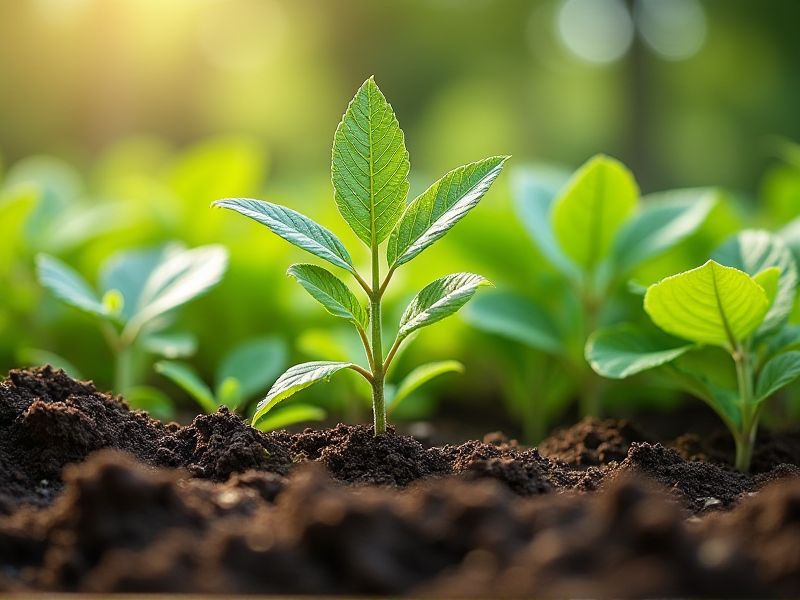
Native plants, such as wildflowers and grasses, play a crucial role in enriching soil health and maintaining ecological balance. Their deep-root systems improve soil structure by enhancing aeration and water retention, preventing erosion in the process. Nitrogen-fixing species, like certain legumes, actively contribute to soil fertility by converting atmospheric nitrogen into a form that plants can utilize. Furthermore, native plants promote biodiversity, attracting local pollinators and beneficial insects essential for healthy ecosystems. Incorporating these plants into your landscape can lead to sustainable gardening practices while supporting local wildlife.
List of some Native plants that enrich soil
- Red Clover (Trifolium pratense)
- White Clover (Trifolium repens)
- Vetch (Vicia sativa)
- Alfalfa (Medicago sativa)
- Lupine (Lupinus perennis)
- Black Locust (Robinia pseudoacacia)
- Pea Plant (Pisum sativum)
- Hairy Vetch (Vicia villosa)
- Cowpea (Vigna unguiculata)
- Soybean (Glycine max)
Important things about Native plants that enrich soil
Symbiotic Relationships With Mycorrhizal Fungi
Mycorrhizal fungi form beneficial symbiotic relationships with native plants, enhancing soil health and nutrient availability. These fungi extend the root systems of plants, allowing them to access water and essential minerals, such as phosphorus and nitrogen, that are often out of reach. In return, native plants provide carbohydrates to the fungi, creating a mutually beneficial exchange that supports biodiversity and ecosystem stability. By promoting these interactions, you can enrich your soil, improve plant resilience, and foster a thriving habitat for other organisms.
Nitrogen Fixation Capabilities
Native plants such as clover and vetch play a crucial role in nitrogen fixation, enhancing soil fertility and supporting ecosystem health. These legumes establish symbiotic relationships with nitrogen-fixing bacteria, converting atmospheric nitrogen into organic forms that are accessible to other plants. By incorporating these native species into your garden or landscaping, you can naturally improve soil structure and nutrient content, reducing the need for synthetic fertilizers. Embracing such native flora not only enriches the soil but also promotes biodiversity and resilience within your local environment.
Deep Root Systems For Aeration
Native plants often possess deep root systems that enhance soil aeration and contribute to soil health. These roots penetrate various soil layers, breaking up compacted layers while allowing water and nutrients to reach deeper plant roots. As these plants die and decompose, they also add organic matter, enriching the soil with essential nutrients and improving its structure. By incorporating native plants into your landscaping, you can support local ecosystems and promote sustainable soil management practices.
Organic Matter Contribution Through Decomposition
Native plants play a crucial role in enriching soil through the decomposition of organic matter, which enhances soil health and fertility. As these plants die and decompose, they release essential nutrients like nitrogen, phosphorus, and potassium, promoting a robust ecosystem for soil microorganisms. This natural process boosts soil organic carbon levels, improving moisture retention and structure, making it easier for other plants to thrive. By incorporating native plants into your landscape, you can enhance biodiversity and create a sustainable environment that supports healthy soil ecosystems.
Erosion Control Through Ground Cover
Native plants serve as effective ground cover for erosion control while simultaneously enriching soil health. These plants are adapted to local climate conditions, requiring less water and fertilizer compared to non-native species. By developing deep root systems, they help stabilize the soil, preventing runoff and promoting moisture retention. Incorporating native species not only supports local biodiversity but also boosts soil organic matter, fostering a healthier ecosystem for surrounding flora and fauna.
Pesticide-Free Pest Management
Native plants play a crucial role in pesticide-free pest management by enhancing soil health and promoting biodiversity. These plants are adapted to local ecosystems, which allows them to thrive without chemical interventions, improving soil structure and fertility. By planting native species, you encourage beneficial insects and natural predators that help control pest populations naturally. Furthermore, native plants contribute organic matter through their decomposing leaves and roots, enriching the soil with nutrients essential for a thriving ecosystem.
Enhanced Biodiversity Support
Native plants play a crucial role in enhancing soil fertility by promoting a diverse ecosystem and improving nutrient cycling. By adapting to local climates and soil conditions, these plants establish deep root systems that aerate the soil and increase organic matter content, which is vital for healthy soil structure. Incorporating native species into your landscape can also attract beneficial insects and pollinators, contributing to a balanced ecosystem. Furthermore, the use of native plants reduces the need for fertilizers and pesticides, leading to more sustainable gardening practices and healthier soil.
Soil Structure Improvement
Native plants play a crucial role in improving soil structure by enhancing its organic matter content and promoting beneficial microbial activity. These plants, adapted to local environmental conditions, develop extensive root systems that help aerate the soil and reduce compaction. When native plants decompose, they contribute organic material that boosts nutrient availability and water retention, ultimately leading to healthier soil ecosystems. Incorporating native species into your landscaping not only enriches your soil but also supports local wildlife and biodiversity.
Drought Resistance And Water Retention
Native plants are crucial for enhancing soil health, particularly in drought-prone areas. Their deep roots help improve water retention, allowing the soil to hold moisture more effectively, which supports overall ecosystem sustainability. By incorporating organic matter into the soil as they decompose, these plants enrich the nutrient profile, leading to better fertility for surrounding flora. You can promote biodiversity and resilience in your landscape by choosing native species that naturally thrive in local conditions.
Natural Habitat For Beneficial Microorganisms
Native plants play a vital role in creating a natural habitat for beneficial microorganisms, fostering a rich soil ecosystem. As these plants grow, their roots release organic compounds and exudates that stimulate microbial activity, enhancing soil health. Rich in nutrients and adapted to local climates, these native species support a diverse array of microorganisms, including bacteria and fungi, crucial for nutrient cycling and organic matter decomposition. By planting native flora, you can enhance soil fertility and promote a thriving community of beneficial microorganisms, ultimately improving garden resilience and productivity.
